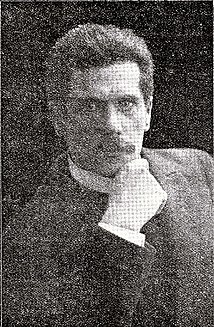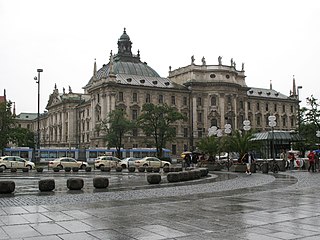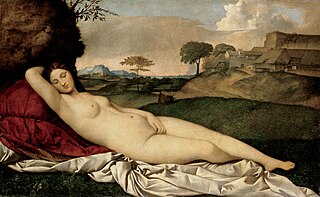
The Börse München is a stock exchange based in Munich, Germany. Founded in 1830, it currently lists over 6300 securities.

The University of Music and Performing Arts Munich, also sometimes called the Academy of Music and Performing Arts, is one of the most respected traditional vocational universities in Germany, specialising in music and the performing arts. The main building it currently occupies is the former Führerbau of the NSDAP, located at Arcisstraße 12, on the eastern side of the Königsplatz, Munich. Teaching and other events also take place at Luisenstraße 37a, Gasteig, the Prinzregententheater, and in Wilhelmstraße (ballet). Since 2008, the Richard Strauss Conservatory (de), until then independent, has formed part of the University.

Holnstein Palace is an historic building in Munich, southern Germany, which has been the residence of the Archbishop of Munich and Freising since 1818.

The Brown House was the name given to the Munich mansion located between the Karolinenplatz and Königsplatz, known before as the Palais Barlow, which was purchased in 1930 for the Nazis. They converted the structure into the headquarters of the National Socialist German Workers' Party. Its namesake was the result of the early Nazi Party uniforms, which were brown. Many leading Nazis, including Hitler, maintained offices there throughout the Party's existence. It was destroyed by Allied bombing raids during the Second World War.
Otto Meitinger was a German architect and preservationist. From 1987 to 1995 he was president of the Technical University Munich.
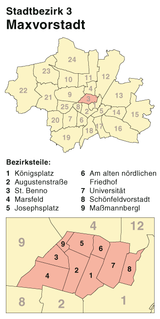
Maxvorstadt is a central borough of Munich, Bavaria, Germany and forms the Stadtbezirk 3 Maxvorstadt. Since 1992, this borough comprises the former boroughs 5, 6 and 7.

Old Botanical garden is located in Maxvorstadt, Munich, Bavaria, Germany.
The following is a timeline of the history of the city of Munich, Germany.

Line S20 is a line on the Munich S-Bahn network. It is operated by DB Regio Bayern. It runs from München-Pasing station to Höllriegelskreuth. It runs on a connecting line from Pasing to München Mittersendling station that has a platform at München Heimeranplatz station, but does not have a platform at München Harras, although the track here lies directly next to the Munich–Holzkirchen line. It is operated during peak hours from Monday through Friday. It is operated using class 423 four-car electrical multiple units.
Alabama-Halle was a concert and theatre venue in Munich, Germany, which was also used to broadcast the television programme Live aus dem Alabama. It was originally part of a military depot.

Sep Ruf was a German architect and designer, belonging to the Bauhaus group. He was one of the representatives of modern architecture in Germany after World War II. His elegant buildings received high credits in Germany and Europe and his German pavilion of the Expo 58 in Brussels, built together with Egon Eiermann, achieved worldwide recognition. He attended the Interbau 1957 in Berlin-Hansaviertel and was one of the three architects who had the top secret order to create the governmental buildings in the new capital city of the Federal Republic of Germany, Bonn. His best known building was the residence for the Federal Chancellor of the Federal Republic of Germany, built for Ludwig Erhard, the so-called Chancellor's Bungalow.

The Fairmont Hotel Vier Jahreszeiten is a luxury hotel located on the Neuer Jungfernstieg in Hamburg, Germany. It is recognized as one of the top hotels in the world. The hotel has received numerous national and international awards and is a member of The Leading Hotels of the World alliance.
Otto Bernheimer was a German collector of art and an antique dealer.
Highlights – Internationale Kunstmesse München is an exhibition of art and antiques in a wide range from ancient to modern. The art fair dates back to the "Deutsche Kunst und Antiquitätenmesse" initiated by Otto Bernheimer in 1956. The event, located in the Munich Haus der Kunst, is held annually in the fall and runs for 10 days. The current initiators of the exhibition are 19 art dealers who have established themselves at The European Fine Art Fair (TEFAF) in Maastricht, Netherlands, over the last two decades.
The Bayerische Theaterakademie August Everding at the Prinzregententheater in Munich, was founded by August Everding in 1993. Since September 2014, the Academy has been directed by Hans-Jürgen Drescher. The academy offers theatrical students nine different programs and through the cooperation of three professionally equipped theaters, it is the largest training center for stage professions in Germany.
Konrad Otto Bernheimer is a German art dealer and collector. He is the chairman and owner of Bernheimer Fine Old Masters in Munich, and was the owner of Colnaghi in London. He sold Colnaghi to the Spanish dealers Jorge Coll and Nicolas Cortés in 2016.

Bernheimer Fine Old Masters was a German art gallery and dealership in Munich, owned by Konrad Bernheimer.

Lehmann Bernheimer was a German antique dealer, who built the Bernheimer-Haus in Munich.
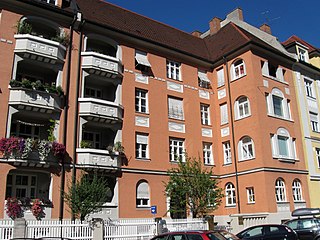
Clemensstraße is a 1.76-kilometer-long street in Munich's Schwabing district. The street, named after Clemens August of Bavaria (1700-1761), labeled under the term Green Axis Schwabing is a participative model project for all Munich municipalities and Munich's longest bicycle road.

The Königinstraße is a street in Munich. It runs west of the Englischer Garten from the Von-der-Tann-Straße in the district of Maxvorstadt, to the north and to the Maria-Josepha-Straße and Mandlstraße in the Ensemble Alt-Schwabing.


